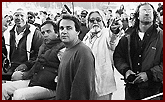Kovacs considers himself fortunate to have worked with some of the best grips in the business, including Gene Kearney, with whom he's worked for 10 years on various projects (including The Legend of the Lone Ranger, filmed in the rugged Southwest), and Gary Kangrga, who's gripped with him for about six years (on such films as Multiplicity, Copycat and The Scout). "Every grip has a different forte an area in which he excels," Kovacs observes, "But basically, all good grips perform well overall. That is important."
Kovacs says that Gene Kearney's special talent is construction. "Gene's an absolutely superior person with an incredible personality who can run a team and relate to everybody. In a way, his forte is 'everything,' but his true expertise lies in building things," says the cameraman. "He can build a camera platform, a car rig you name it. Gary is also good about helping to create a lighting effect. I have a huge 20K unit, and if I tell him I want to diffuse and take the soft light out, he's always incredibly well prepared. In a matter of seconds, he can give me the right kind of diffusion and control it so it doesn't spill everywhere."
Both Kearney and Kangrga have high regard for Kovacs. Kearney offers, "In this line of work, you tend to have favorite cinematographers with whom you form personal and professional relationships. With those people, you can understand in one initial conversation how a film will be shot, the look it will have, and whether or not it will be done in moving shots or in a more classic style with stationary setups."
Kearney says that Kovacs and Sven Nykvist, ASC are two of his favorite cinematographers. He explains, "They've got a tremendous amount of experience, so they can be very specific in describing what they want to do. I always know how a scene will be lit or blocked; there's no experimenting as we go along. The most complicated setup can become very simple. Even after some 30-odd years, I still look forward to working with those two men in particular."
Kearney has vivid memories of shooting Cannery Row with Nykvist. An entire waterfront town had to be built on an MGM stage, with the streets tunneled through two studio blocks. "I was lucky to have four weeks of experimenting with day and night looks, rain and fog, morning and sunset. That was a film I won't forget, because it's the kind few people get the opportunity to do anymore. We had to use lighting to create different times for a town that didn't really exist."
When Kearney worked with Kovacs on the romantic comedy Say Anything, starring John Cusack and Ione Skye, the actors had to deliver pages of dialogue in a moving car. "Young actors don't do the same thing over and over," Kearney notes, "so for this picture, we decided to shoot the day and night moving car interiors with four to five cameras mounted on the car, simultaneously. That type of setup is tricky, because what's good for one camera isn't necessarily good for the others. Each cut had to match so we could avoid having to do the dialogue all over again from another angle. And each cut did match perfectly. It was a tremendous time-saver."
Kangrga says of Kovacs, "He's a great person, a great personal friend, and a genius at what he does. When we work together, I try to be as accessible as possible, yet also stay out of his hair, because he's constantly rethinking and reshaping ideas."
The grip was particularly impressed with the complicated shots Kovacs designed for the thriller Copycat. "Basically, the camera was always moving. We used a lot of Steadicam shots, and we gave Chris Squires, the camera operator, maximum flexibility to negotiate doorways." One shot started in a second floor bedroom and went downstairs; Kangrga safetied Squires, who doubled as operator/Steadicam operator. Squires backed down the stairs, moving through several doorways and down another flight of stairs into a basement. At the point when Squires backed out of the way to let the talent walk in front of the lens, a landing had to be built to give him a place to stand before he proceeded down the stairs. "At that point," says Kangrga, "the long shot wasn't even half done yet, but it was so well-designed that the result was very dramatic. It showed the depth of the conceptualization and of Laszlo's vision for the scene, which he developed with [director] Jon Amiel. Being around that kind of creativity is a tremendous inspiration."
Kangrga faced a completely different challenge with Kovacs on Free Willy 2. "All of the whales were animatronic, but that didn't make it easier than working with live animals," he notes. "At the end of the workday, they'd go into the shop to be rebuilt, and we had to worry about whether the action would match what we needed them to do. Worse still were the elements the changing tide and the weather in the San Juan Islands."
Kangrga notes that he and Kovacs team up even when they're not on the set. "We enjoy good conversation and a good bottle of wine," says Kangrga. "When we're working, I try to make him look good, just as the guys I hire make me look good. We've occasionally found ourselves in unpleasant situations, but we always work hard and smart. The camaraderie always makes it worthwhile."
